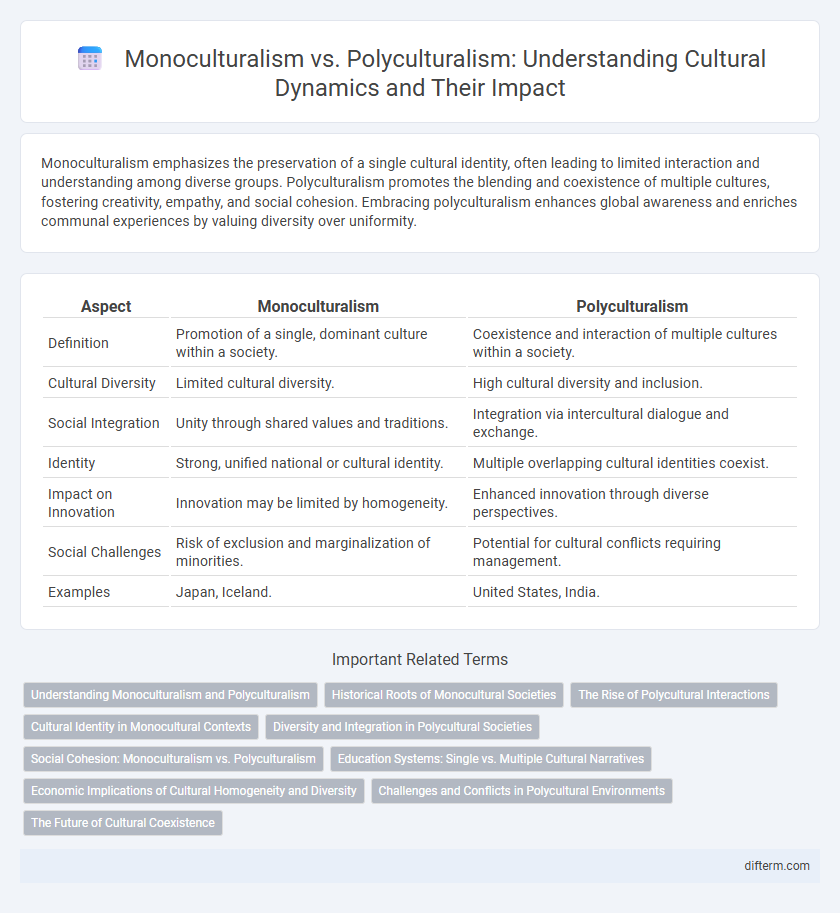Monoculturalism emphasizes the preservation of a single cultural identity, often leading to limited interaction and understanding among diverse groups. Polyculturalism promotes the blending and coexistence of multiple cultures, fostering creativity, empathy, and social cohesion. Embracing polyculturalism enhances global awareness and enriches communal experiences by valuing diversity over uniformity.
Table of Comparison
| Aspect | Monoculturalism | Polyculturalism |
|---|---|---|
| Definition | Promotion of a single, dominant culture within a society. | Coexistence and interaction of multiple cultures within a society. |
| Cultural Diversity | Limited cultural diversity. | High cultural diversity and inclusion. |
| Social Integration | Unity through shared values and traditions. | Integration via intercultural dialogue and exchange. |
| Identity | Strong, unified national or cultural identity. | Multiple overlapping cultural identities coexist. |
| Impact on Innovation | Innovation may be limited by homogeneity. | Enhanced innovation through diverse perspectives. |
| Social Challenges | Risk of exclusion and marginalization of minorities. | Potential for cultural conflicts requiring management. |
| Examples | Japan, Iceland. | United States, India. |
Understanding Monoculturalism and Polyculturalism
Monoculturalism centers on a single cultural framework, emphasizing uniformity and preserving traditional values within a society. Polyculturalism embraces the coexistence and interaction of multiple cultures, fostering mutual exchange and dynamic cultural evolution. Understanding these concepts highlights the impact on social identity, inclusion, and cultural adaptability in diverse communities.
Historical Roots of Monocultural Societies
Monocultural societies often trace their historical roots to geographical isolation and centralized political systems that promoted uniform traditions and beliefs. These societies typically emerged from early agrarian civilizations where cultural homogeneity was reinforced through shared language, religion, and social norms. The consolidation of power by dominant groups historically suppressed minority cultures, further entrenching monocultural identities.
The Rise of Polycultural Interactions
Polyculturalism emphasizes dynamic interactions and exchanges among diverse cultures, fostering innovation and social cohesion through shared experiences and mutual adaptation. Unlike monoculturalism, which promotes homogeneous cultural norms and limits cross-cultural engagement, polyculturalism encourages hybrid identities and greater intercultural empathy. The rise of global communication networks and increased migration fuels polycultural interactions, reshaping social landscapes and expanding cultural horizons worldwide.
Cultural Identity in Monocultural Contexts
Cultural identity in monocultural contexts often centers on shared language, traditions, and historical narratives that reinforce a singular societal framework. This homogeneity can foster strong social cohesion and a clear sense of belonging but may also limit exposure to diverse perspectives and reduce cultural adaptability. Monocultural environments emphasize preservation of core values, which can impact integration strategies and educational approaches within these societies.
Diversity and Integration in Polycultural Societies
Polyculturalism emphasizes the dynamic interaction and integration of diverse cultural groups, fostering mutual respect and fluid identity boundaries within societies. This approach enhances social cohesion by recognizing and valuing cultural hybridity rather than enforcing rigid, isolated cultural norms typical of monoculturalism. Research shows that polycultural frameworks support innovation and conflict resolution by encouraging cross-cultural communication and shared community participation.
Social Cohesion: Monoculturalism vs. Polyculturalism
Monoculturalism promotes social cohesion by fostering shared values and traditions within a homogeneous group, enhancing unity and minimizing cultural conflicts. Polyculturalism encourages interaction among diverse cultural groups, strengthening social bonds through mutual respect and cross-cultural understanding. Balancing monocultural stability with polycultural inclusivity contributes to resilient and dynamic societies.
Education Systems: Single vs. Multiple Cultural Narratives
Monocultural education systems emphasize a single cultural narrative, often reflecting the dominant group's history, values, and perspectives, which can limit students' understanding of diverse cultures. Polycultural education integrates multiple cultural narratives, fostering cross-cultural awareness, empathy, and critical thinking by exposing students to varied traditions and worldviews. Curriculum design in polycultural systems promotes inclusivity and prepares learners to navigate globalized societies, enhancing social cohesion and reducing cultural biases.
Economic Implications of Cultural Homogeneity and Diversity
Economic implications of monoculturalism often include limited innovation and reduced adaptability to global markets due to homogeneous perspectives and skills. In contrast, polyculturalism fosters economic growth by leveraging diverse cultural insights, enhancing creativity, and expanding access to international networks and consumer bases. Companies embracing cultural diversity report higher profitability and improved problem-solving capabilities in competitive environments.
Challenges and Conflicts in Polycultural Environments
Polycultural environments often face challenges such as identity conflicts and communication barriers arising from diverse cultural norms and values. Misunderstandings and stereotypes can intensify tensions, leading to issues in social cohesion and workplace efficiency. Addressing these conflicts requires intercultural competence and inclusive policies that promote mutual respect and dialogue among different cultural groups.
The Future of Cultural Coexistence
Monoculturalism often limits societal growth by promoting uniform values and inhibiting cross-cultural dialogue, whereas polyculturalism fosters innovation through diverse perspectives and shared experiences. Emerging global trends highlight increased interconnectivity and migration, suggesting polycultural frameworks will enhance social cohesion and economic resilience. Future cultural coexistence depends on embracing hybrid identities and inclusive policies that balance cultural preservation with dynamic intercultural exchange.
monoculturalism vs polyculturalism Infographic

 difterm.com
difterm.com